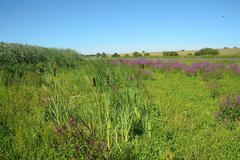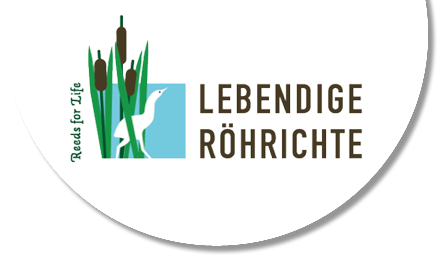Floating Leaf Vegetation
Floating leaf plants have specially adapted to a life in water. Their leaves float on the water surface and can thus make optimum use of CO2 and light. The floating leaves are mostly round, kidney-shaped or oval. The tops of them repel water. The familiar “lotus effect” is due to the self-cleaning properties of the floating leave, especially of water lilies and lotuses.
Floating leaf plants increase the structural diversity of water bodies. In the water, they are small, special habitats. On the water surface, thanks to their large leaf surfaces, they are ideal places for insects to lay their eggs and breeding habitats for birds, such as the black tern. Floating leaf plants are thus both a feeding and a breeding habitat.
Characteristic species of floating leaf vegetation at the Bienen Old Rhine are the yellow floating heart (Nymphoides peltata), the white water lily (Nymphea alba) and the yellow water lily (Nuphar lutea). The yellow floating heart has golden yellow flowers with toothed edges. The flowers of the white water lily are white, up to 15 cm in diameter and float on the surface of the water. The ball-shaped flowers of the yellow water lily stand up on individual stalks and are yellow.
The floating leaf plants in the project area have been affected by a drastic fall. Between 1995 and 2015, their population fell by 46.4 %. The white water lily (Nymphea alba) has now almost completely disappeared.
Neuigkeiten
Ausstellung im Rheinmuseum

Im Rheinmuseum Emmerich findet am 25. April eine Lesung "Der Rhein" - Biographie eines Flusses mit…
Termine

Expedition ins lebendige Röhricht - Pflanzen und Tiere am Ufer des Bienener Altrheins entdecken
01.09.2024 10:00 - 12:30
Referenten: Martin Brühne, Achim Vossmeyer Treffpunkt: Naturschutzzentrum im Kreis Kleve, Niederstraße 3, 46459 Rees-Bienen Gebühr: kostenlos Anmeldung: 02851 / 96330 [...]
More

![[Translate to englisch:] Seekanne](/fileadmin/_processed_/b/0/csm_Seekanne_Kolk_512_5_Br%C3%BChne_3.9.2012__fe4e122be4.jpg)



